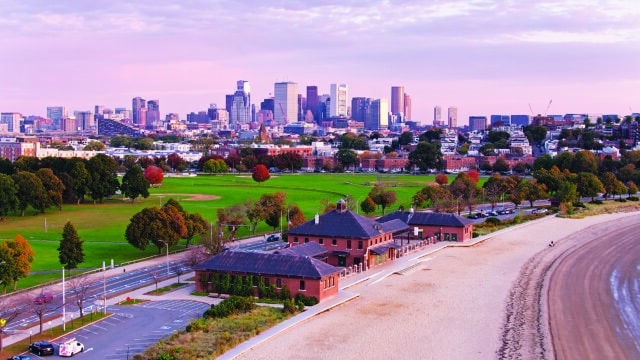
A partnership between Dorchester Bay City developers and state and local agencies could provide benefits in preventing devastating coastal flooding in four Boston neighborhoods. Image courtesy of Stantec
As the largest real estate development under review in Boston, the 6.5 million-square-foot Dorchester Bay City could take responsibility for protecting not only its own vulnerable waterfront site from flooding, but large sections of surrounding neighborhoods.
Developer Accordia Partners agreed to contribute $18.5 million toward a storm barrier outside its property lines, blocking a flood pathway that’s projected to threaten a population of 35,000 people in Dorchester, Roxbury and South End during a major storm, according to Boston climate studies.
“Resiliency is a team sport,” Accordia Partners Principal Richard Galvin said. “You can’t do it on your own. It has to be in collaboration with your neighbors up and down the coastline.”
Accordia Partners’ teammates on the 22-foot-high storm barrier are the city of Boston and the Massachusetts Department of Conservation & Recreation, owners of neighboring parkland.
Still in the early planning stages, the project represents a milestone in a shift toward neighborhood-wide resiliency strategies, rather than a parcel-by-parcel approach. The vision: a contiguous barrier including Accordia’s private development site, the DCR’s Dorchester Shores Reservation and the city-owned Moakley Park in South Boston.
“I hope it raises the bar and sets a new standard, because it’s absolutely what we all know we have to do,” said Kathy Abbott, CEO of Boston Harbor Now. “We can’t do this on a parcel-by-parcel approach.”
The project represents a departure from Boston’s planning for the Seaport District, where developments were approved and completed first, and resiliency projects such as the Fort Point Channel flood berm are just now being designed.
Because parcel-by-parcel resiliency projects merely shift flood waters onto neighboring properties, environmentalists and coastal activists have repeatedly called for construction of neighborhood-wide barriers. A conceptual proposal released this summer by the nonprofit Wharf District Council would elevate a 1.5-mile section of seawalls and Boston Harborwalk to protect the downtown waterfront, Financial District and Rose Kennedy Greenway.

State and city officials, along with developer Accordia Partners, envision a continuous set of storm defenses along Moakley Park and part of Columbia Point that could protect the Dorchester Bay City development and 35,000 residents in other neighborhoods. iStock photo
Hundreds of Buildings at Risk by 2030
The Dorchester Bay City project, expected to be built out over two decades, would include nearly 2,000 housing units along with office, lab and retail space. Accordia Partners leases the former Bayside Expo property from the University of Massachusetts Building Authority, and the 36-acre site also includes an office park on the inland side of Morrissey Boulevard and 180 Mount Vernon St.
The site sits in an area where a projected 40-inch rise in sea levels by 2070 could bring widespread flood damage and disruption in coming decades. Developers estimate it will cost $114 million to elevate the entire Dorchester Bay City site to protect buildings from rising seas.
Morrissey Boulevard, which runs past the entrance to the future development, routinely floods and is closed to traffic during monthly high tides. The MBTA Red Line and Interstate 93 would be inundated during major storms by 2050, the city’s 2020 Coastal Resilience Solutions Dorchester report predicts. As soon as 2030, a major flood would threaten 400 buildings in Dorchester with a value of $4.5 billion.
While funding sources and costs are undetermined, the city of Boston, DCR and MWRA are collaborating on a planning and design study for the district-wide barrier, known as the “Moakley Connector.” The city received a $1.6 million FEMA pre-disaster grant to pay for the study, expected to be completed in 2025 or 2026.
The city is separately planning a resiliency project on the 60-acre Moakley Park property including an earthen berm and plantings designed to absorb flood waters.
“It is necessary to extend the resilience investment planned for Moakley Park to the areas immediately [north and south] to completely close down the flood pathway,” Boston Commissioner of Environment Alison Brizius wrote in a comment letter to the Boston Planning & Development Agency.
Developers are hoping for a BPDA board vote on the project as soon as mid-September.
Since they filed their original proposal in 2019, Dorchester Bay City developers have made several changes in response to public comments.
A 2.7-acre waterfront park including a 6,300-square-foot public pavilion replaced one building, while two other buildings were relocated further from the DCR-owned shoreline. The total open space component was expanded from 6.8 to 9 acres.
Uncertainties About Costs, Responsibilities
But uncertainties remain about the construction of the Moakley Connector and the complexities of coordinating the project among multiple agencies and landowners.
Details such as which public agency will coordinate the project, and how the cost will be split between public and private parties, have yet to be determined.

Steve Adams
In a BPDA comment letter, Boston Harbor Now’s Abbott also asked developers for more details on how the coastal barrier will retain public access to Boston Harbor, and how the development’s public park space will be maintained and operated.
One financial commitment appears secure, pending the project’s approval: Accordia Partners’ $18.5 million contribution, all of which is expected to be submitted by the first phase of construction.
“We’re prepared to front-load our investment to make these things happen sooner rather than later,” Galvin said. “It’s a significant off-site investment and more importantly, it’s a significant opportunity to show public-private collaboration in a way that can be replicated around the region.”





